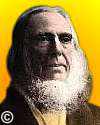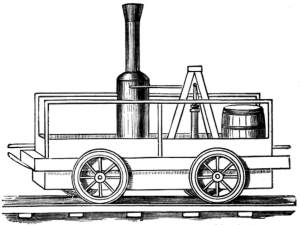 (source)
(source)
|
Peter Cooper
(12 Feb 1791 - 4 Apr 1883)
American inventor, manufacturer and philanthropist who built America's first steam locomotive, the Tom Thumb. He founded The Cooper Union for the Advancement of Science and Art in New York.
|
Peter Cooper's Locomotive - Tom Thumb
From: Wonders and Curiosities of the Railway (1884)
[p.38] The curtain next rises upon an unusually attractive scene in which the figure of the noble philanthropist and manufacturer, Peter Cooper, is the centre of interest. It curiously marks the recent origin of the railroad system that the man (Peter Cooper), who built the first railroad locomotive ever made in America, was alive in 1882, and yet was forty years old when he constructed his locomotive. Mr. Cooper not only built the first American locomotive, but what was more important, he proved that it could run [p.39] at a high rate of speed round curves of a short radius. In consideration of these services he has been called “The Father of the Locomotive System in America.”
In 1826 Baltimore woke up to the fact that she must do something to regain the trade that the Erie canal and the roads of Pennsylvania were taking out of her hands. It was decided to build a railroad through the Potomac Valley and over the Alleghanies. The first section of the road was opened in 1830. It consisted of a double track extending thirteen miles to Ellicott's Mills. “What motive-power shall we have?” that was the great question. The horse-car experiment did not pay, and various other devices were tried. Evan Thomas built for the road a car with sails, which ran when the wind was favorable. Baron Krudener, Russian envoy to this country, rode on this car, and managed the sail himself, declaring that he was charmed with his ride. But the thing was of little value. Then they tried a horse-power car, a machine somewhat like the wood-cutting apparatus we see at railway stations, only the horse on the Baltimore road propelled himself and his fellow passengers over the rails instead of sawing wood with a buzz-saw. The horse-power car worked pretty well, but on one occasion, when drawing a number of editors and other representatives of the press, the machine ran into a cow, and ignominiously upset the inspecting company in a ditch. And, inasmuch as the company had to endure thereafter innumerable bad jokes and puns (for example, “the cowed editors”), they naturally passed an unfavorable verdict upon the machine which had subjected them to this annoyance.
How it next came to pass that Peter Cooper built his little engine, the “Tom Thumb,” and made his famous [p.40] trial-trip on the railroad, he must be allowed to tell in his .own graphic way.1
“It is now about fifty-five years since I was drawn into a speculation in Baltimore. Two men there, whom I knew slightly, came up and asked me to join them in buying a tract of three thousand acres of land within the city limits. It included the shore for three miles, and the new Baltimore and Ohio railroad was going to run through it. The road was chartered, and a little of it was graded. Its cars were to be drawn by horses; nobody thought of the possibility of steam. I consulted my friend Gideon Lee, who served as alderman with me fifty-two years ago now, and he advised me that it was a good scheme. He said the land was worth five hundred thousand dollars, whether the road was ever finished or not. So I went to Baltimore, saw the land, and agreed to take one-third, and paid my money, twenty thousand dollars.
[p.41] “They drew on me every little while for taxes, etc., and when, at the end of a year, I went down again, I found out that neither of my partners had paid a cent on the purchase, and that I had been sending down money to pay their board! The Baltimore and Ohio railroad had got some wooden rails laid, and thinking it might amount to something, I bought my swindling partners out, paying one of them ten thousand dollars. I thought it would pay, for the Baltimore and Ohio railroad had run its tracks down to Ellicott's Mills, thirteen miles, and had laid ‘quakehead’ rails, as they called them, strap rails, you know, and had put on horses. Then they began to talk about the English experiments with locomotives. But there was a short turn of one hundred and fifty feet radius around Point of Rocks, and the news came from England that Stephenson said that no locomotive could draw a train on any curve shorter than a nine hundred foot radius. The horse-car didn't pay and the road stopped. The directors had a bad fit of the blues. I had naturally a knack at contriving, and I told the directors that I believed I could knock together a locomotive that would get the train around Point of Rocks. I found that my speculation was a loss unless I could make the road a ‘go.’
“So I came back to New York and got a little bit of an engine, about one horse-power (it had a three and a half inch cylinder, and fourteen inch stroke), and carried it back to Baltimore. I got some boiler iron and made a boiler, about as big as an ordinary wash-boiler, and then how to connect the boiler with the engine I didn't know.”
“You had been a worker in wood, I believe,” said the gentleman to whom this narrative was imparted by Mr. Cooper.

[p.42] “Yes, and in iron, too. I had not only learned coach-making and wood carving, but I had an iron-foundry and had some manual skill in working in it. But I couldn't find any iron pipes. The fact is that there were none for sale in this country. So I took two muskets and broke off the wood part, and used the barrels for tubing to the boiler, laying one on one side and the other on the other. I went into a coach-maker's shop and made this locomotive, which I called the ‘Tom Thumb,’ because it was so insignificant. I didn't intend it for actual service, but only to show the directors what could be done. I meant to show two things: first, that short turns could be made; and, secondly, that I could get rotary motion without the use of a crank. I effected both of these things very nicely. I changed the movement from a reciprocating to a rotary motion. I got steam up one Saturday night; the president of the road and two or three gentlemen were standing by, and we got on the truck and went out two or three miles. All were very much delighted, for it opened new possibilities for the road. I put the locomotive up for the night in a shed. All were invited to a ride Monday—a ride to Ellicott's Mills. Monday morning, what was my grief and chagrin to find that some scamp had been there, and chopped off all the copper from the engine and carried it away—doubtless to sell to some junk dealer. The copper pipes that conveyed the steam to the piston were gone. It took me a week or more to repair it. Then (on Monday it was) we started—six on the engine and thirty-six on the car. It was a great occasion, but it didn't seem so important then as it does now. We went up an average grade of eighteen feet to the mile, and made the passage (thirteen miles) to Ellicott's Mills in an hour and twelve minutes.
[p.43] We came back in fifty-seven minutes. Ross Winans, the president of the road, and the editor of the ‘Baltimore Gazette,’ made an estimate of the passengers carried and the coal and water used, and reported that we did better than any English road did for four years after that. The result of that experiment was that the bonds of the road were sold at once, and the road was a success.”
From other sources2 we are enabled to supplement Mr. Cooper's narrative in a few points. One of the passengers—Mr. H. H. Latrobe—says that the trip to the Mills was most interesting. The curves were passed without difficulty, at a speed of fifteen miles an hour; the grades were ascended with comparative ease; the day was fine, the company in the highest spirits, and some excited gentlemen of the party pulled out memorandum-books, and when at the highest speed, which was eighteen miles an hour, wrote their names and some connected sentences, to prove that even at that great velocity it was possible to do so.
The “Tom Thumb” weighed about a ton; the wheels were two and a half feet in diameter; the fuel, anthracite coal. The smoke-stack “looked like an aggravated putty-blower.” The tubes in the upper part of the boiler were an anticipation, or rather an independent and almost simultaneous invention of the multi-tubular arrangement of George Stephenson, which, together with the steam-blast, gained him the victory at Rainhill, a year after the “Alderman Cooper” experiment. It is important to remember the fact of the prior and independent invention in America of two of the fundamental features of all locomotives. Mr. Cooper's steam-blast apparatus consisted of a sort of [p.44] bellows, which was operated by a belt running over a drum and geared with the car-wheels. But it was this very steam-blast device which lost the “Tom Thumb” the race with a horse owned by the stage proprietors, Stockton and Stokes, of Baltimore. The little engine had been out a number of times, and although starting off with much puffing and leaking of steam from its joints, had answered all the expectations of its ingenious inventor. But on the day of trial just described, the stage proprietors, having learned that the engine was on the track, “brought down a gallant gray of great beauty and power, and attached him to a car on the second track, and met the returning engine at the Relay House—so called because relays of horses were generally procured there. From this point they determined to have a race back, and away went horse and engine—the snort of the one keeping time to the puff of the other. The gray had the best of it at first, getting a quarter of a mile ahead while the engine was getting up its steam. The blower whistled, the steam blew off in vapory clouds, the pace increased, the passengers shouted, the engine gained on the horse, lapped him, the silk was applied, the race was neck-and-neck, nose-to-nose; then the engine passed the horse, and a great hurrah hailed the victory. But just at this moment, when the gray's master was about giving up, the band which turned the pulley that moved the blower slipped from the drum, the safety valve ceased to scream, and the engine, for want of breath, began to wheeze and pant. In vain Mr. Cooper, who was his own engineer and fireman, lacerated his hands in attempting to replace the band on the wheel; the horse gained on the machine, and passed it, to his great chagrin; and, although the band was presently replaced, and steam [p.45] again did its best, the horse was too far ahead to be overtaken, and came in winner of the race.”
- Science Quotes by Peter Cooper.
- 12 Feb - short biography, births, deaths and events on date of Cooper's birth.
- 28 Aug - births, deaths and events on date of Tom Thumb locomotive's first run.
- The Cooper Union history.
- Peter Cooper, by Rossiter W. Raymond. - book suggestion.
- Booklist for steam locomotive history.




